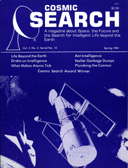![[NAAPO Logo]](../../Images/NAAPOsm.jpg) North American AstroPhysical Observatory (NAAPO)
|
|
Letters:
By: Editors
Letters are always welcome but owing to the volume it is not possible to acknowledge all of them. Also due to space limitations we reserve the right where necessary to condense or edit the contents. Letters may be addressed to: Editorial Dept., COSMIC SEARCH, P.O. Box 293, Delaware, Ohio 43015.
In his recent COSMIC SEARCH article, In Which Klingons Became Chimeras, Frank Drake puts forward conclusive common-sense evidence that the United States will not embark on a program of interstellar colonization in the near future. Dr. Drake's further conclusion that there are no intersteller empires, far from demonstrating the fallacy of Star Trekitis, serves merely to demonstrate a sad case of Saganism, the condition wherein university professors and radio astronomers become convinced that the entire universe is populated by other university professors and radio astronomers.
If current human technology is the pinnicle [sic; "pinnicle" should be "pinnacle"] of possible technology; if no further basic scientific breakthroughs will ever be made anywhere in the universe, then Dr. Drake's conclusions are probably correct. However, even something as trivial as a good fusion reactor makes interstellar travel a reasonable, if somewhat expensive, long-term operation. There are several excellent, logical reasons for interstellar colonization (Klingon groups might go just to get away from other Klingons) and many irrational ones. If there are a large number of technical civilizations, the odds are that many of them will find such reasons persuasive. Far more reasonable explanations for the absence of aliens on Earth are that we aren't on good travel routes or that advancing technology so alters the nature of technical civilizations that empire building (if it occurs) is a short-lived phase (cosmicly speaking). Dr. Drake's comments on radio and CETI bring to mind the nineteenth century astronomers who speculated that the reports of flashes observed on Mars might be explosions set off by an intelligent, advanced race trying to signal us. After all, what other method could an advanced technology use to communicate across interplanetary distances?
Good luck with this wonderful magazine.
|
